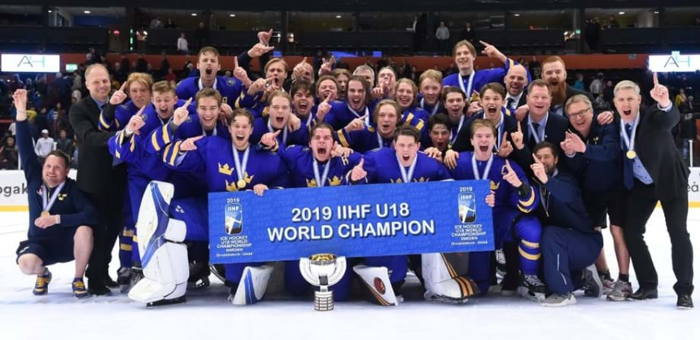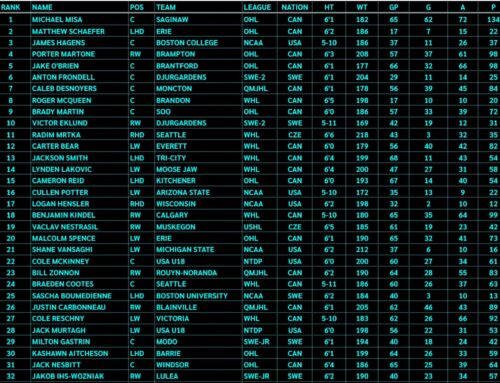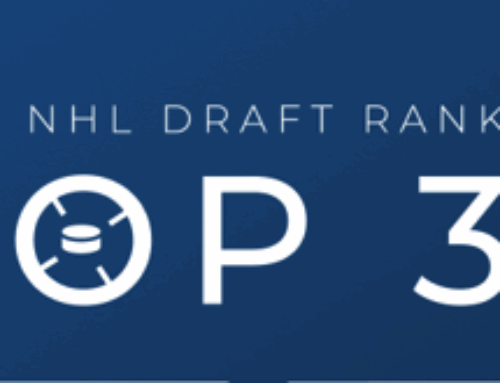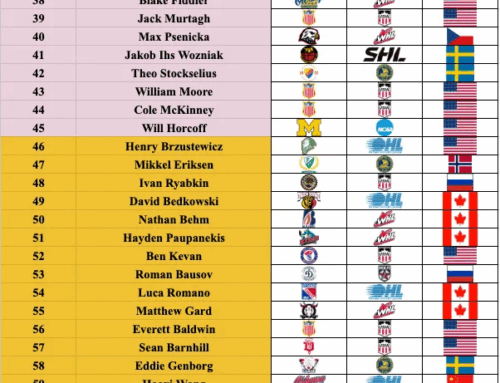Tournament Review: U18 Worlds – Part 2
Jokke Nevalainen
2019-04-30

The U18 Worlds are now over. Sweden won their first ever gold medal at the under-18 level, and doing it while hosting the tournament must feel extra special. Here’s the second part of my tournament review where I go through all the teams from Group B. In case you missed the first part where I went through all the teams from Group A, here’s a link to it: Tournament Review: U18 Worlds – Part 1.
In case you missed the articles I posted during the tournament, here are links to them. I did a bunch of interviews while in Sweden, and I included most of them in those articles.
- First Update from the U18 Worlds (Apr 20)
- Second Update from the U18 Worlds (Apr 22)
- Third Update from the U18 Worlds (Apr 24)
Slovakia
Winger Maxim Cajkovic (2019) led the team in points with three goals and seven points in seven games. Cajkovic is projected to go in the second round this summer, and his goal-scoring ability was well-known even before this tournament. He has a great shot but the other parts of his game still need some work. He carried an ‘A’ on his chest for the Slovaks.
Another winger who really impressed me was Martin Chromiak (2020) who had two goals and three points in seven games. I wasn’t familiar with him beforehand but saw a lot of potential, so I’m looking forward to see more of him next season.
On defense, Samuel Knazko (2020) was arguably Slovakia’s top defenseman despite being an underager – and he was also their alternate captain. He’s a good puck-mover who also played well on the power play but was held pointless in the tournament. He also made a few massive mistakes which will likely haunt him for a little bit.
Goalie Samuel Hlavaj (2019) is highly-ranked and he played well in this tournament but his numbers (.894 SV%) suffered because of the team in front of him. At 6-foot-4, Hlavaj has great size, and he has already played at the World Juniors as well.
Chromiak and Knazko are eligible to play at the under-18 level next year but they won’t be able to do it at the top level because Slovakia was relegated after losing a three-game series to Switzerland. Those two will have to work hard to get their country back to the top level in 2020.
Latvia
I have absolutely nothing on this team. No one on the team had more than two points, and none of their players stood out when I watched them. Well, I guess you could say their goalie Arturs Silovs (2019) stood out because he was the reason Latvia avoided relegation round. He’s a big kid at 6-foot-4, and his .918 save percentage in five games is really impressive considering the team in front of him.
USA
Team captain and projected first overall pick Jack Hughes (2019) led the tournament in points. He had nine goals and 20 points in seven games which is all kinds of incredible. In fact, 20 points is the second highest single-tournament point total in the history of the U18 Worlds – just one point shy of Nikita Kucherov’s record. That was good enough to earn a spot on the Media All-Star team. Hughes’ combined point totals of 32 points over the past two years in the event is a new record, though, as he broke Alex Ovechkin’s previous record by one point.
But Hughes didn’t get his second consecutive U18 Worlds MVP selection because that award (as well as “Best Forward”) was handed to his winger and alternate captain Cole Caufield (2019) who led the tournament with 14 goals, and his 18 points was six more than the guy in third place in tournament scoring. Caufield was also selected to the Media All-Star Team. Caufield tied Ovechkin’s single-tournament record with his goal total which is an incredible feat. If it wasn’t for his size (5-7, 163) and good but not great skating ability, he would be a top-three pick in the summer. But after a strong tournament like this, cracking the top-10 isn’t out of the question.
Playing left wing with those two was Trevor Zegras (2019) – although he missed the first two games because of an injury and wasn’t at 100% after that either. Zegras failed to score a goal but had nine assists in five games, so that’s not bad at all. Zegras is a natural center but has been used on the wing pretty often as well. He’s a flashy offensive player who is loads of fun to watch because of his skill and vision. He also joined Hughes and Caufield on the top power play unit. He’s a projected top-10 pick.
The fourth forward on USA’s top power play unit was Alex Turcotte (2019) who centered USA’s second line at even strength and finished the tournament with four goals and nine points in seven games. Turcotte is a very competitive two-way center with average size (5-11, 185) but there’s very little stopping him from becoming a number one center in the NHL. He plays a strong 200-foot game but also has a lot of offensive talent. I wouldn’t be surprised if he was drafted in the top-five this summer.
On the left side of Turcotte was Matthew Boldy (2019) who finished third in tournament scoring with three goals and 12 points in seven games. Boldy got to play on the top power play unit until Zegras arrived but he still got to play on the second unit after that. Boldy is a very good two-way winger with good size (6-2, 192). He carried an ‘A’ on his chest, killed penalties, and the coach spoke very highly of him. There’s a lot to like, and he’s yet another projected top-10 pick this summer.
On the right side of that line was Bobby Brink (2019) who joined the team mid-tournament but definitely made an impression, scoring three goals and six points in five games. He didn’t play with the National Team Development Program this season but found instant chemistry. Brink isn’t quite a top-10 pick like the other five guys in their top-six but he’s a first-rounder for sure. He has average size (5-10, 163) and his skating isn’t a strength. But he’s pretty young for his draft class, and he has amazing offensive abilities.
USA’s bottom-six definitely pales in comparison to their top guys but there’s one additional player in there who could be a first-rounder this summer, and that’s center John Beecher (2019). He finished the tournament with three goals and four points in seven games. Beecher is a very good two-way power forward with great size (6-3, 209). He’s a great skater for his size, and even though he was mostly used in a defensive role, he isn’t without skill. He hasn’t been given power play time because the team is so stacked up front but Beecher has been a regular on the penalty kill where he excels. Beecher may not become more than a third-line center at the NHL level but he’s the type of player every team would love to have on their roster, especially in the playoffs.
On defense, USA relied heavily on Cam York (2019) who is yet another first-rounder on this team. He scored four goals and 11 points in seven games which led all blueliners in goals and points. York played big minutes, including on the top power play alongside Hughes, Caufield, Turcotte and Zegras. That unit was as deadly as it sounds. After a strong tournament like this, it wouldn’t be surprising to see York as the second defenseman drafted next summer.
Alex Vlasic (2019) is another defenseman on the team who could potentially go in the first round this summer. He’s a massive (6-6, 198) guy who is also pretty young for his draft class. He’s a fine skater for someone his size, and even though he only got one point in the tournament, he has some offensive ability as well. He won’t be a big-time producer at the pro level but he isn’t a liability either. A lot of NHL teams would love to have a guy like him patrolling their blue line.
As if it wasn’t enough that USA had seven potential first-rounders up front and two of them on the blue line, they also had one in goal. Spencer Knight (2019) is the top goalie in his draft class, and even though goalies rarely go in the first round these days, he’s one of those guys who will do exactly that. He has great size (6-3, 198), and this was already his second U18 Worlds tournament. His .936 save percentage led all goalies in the event, and he played six out of USA’s seven games.
But despite having arguably the best roster ever seen at the U18 Worlds, Team USA failed to get to the gold medal game after a shootout loss to Russia in the semi-final. USA did manage to regroup after that, though, and they had a decisive win against Canada to win bronze. It’s not the medal they were hoping to get but at least they got something from their trip to Sweden.
Russia
The biggest reason for Russia’s spot in the gold medal game was their goalie Yaroslav Askarov (2020) who stood on his head in the game against USA. Askarov was selected as the Best Goalie in the tournament, and also found his spot on the Media All-Star Team. The important thing to remember is that he’s a 16-year-old who is eligible to return next year as well. Askarov has great size (6-3, 163), and he’s had a really good season in the MHL. Askarov is a projected top-15 pick in 2020, and arguably a better prospect than Knight – maybe the best goalie prospect we’ve seen for a long time. But Askarov wasn’t at his best in the gold medal game, allowing a couple of goals he usually would have stopped. It may have been because it was a back-to-back situation and he’s probably not used to those.
Russia’s captain and top-line winger Vasili Podkolzin (2019) didn’t have a great tournament but he came alive in the gold medal game where he was arguably Russia’s best player. He finished the tournament with one goal and four points in seven games but half of those points came in the final game. There has been a lot of speculation that perhaps Podkolzin was injured during the tournament or perhaps it was just fatigue affecting his game. Until we know more, it’s hard to judge his performance. The good thing for him was that he looked like a top-10 pick in the gold medal game at least.
Podkolzin’s center and alternate captain Ilya Nikolayev (2019) had two goals and four points in seven games. He had a fine tournament as well but perhaps didn’t do enough to convince most people he deserves to be drafted in the first round. He’s a reliable two-way center with good skill level and decent size (6-0, 190). And similar to Podkolzin, he’s young for his draft class (they’re born just two days apart).
But it was the third member of that top line, winger Rodion Amirov (2020) who led the team in goals and points. He had six goals and nine points in seven games, and that was good enough for a spot on the Media All-Star Team. Amirov is born late in 2001 which pushes his draft-eligibility to 2020. It will be interesting to see if he can play at the pro level in Russia next season.
Russia’s second line center Yegor Spiridonov (2019) was second in team scoring with two goals and six points in seven games. He’s a two-way center with great size (6-2, 192) and a very good shot, and he’s projected to be drafted somewhere in the second round this summer. Some are suggesting he’s better than Nikolayev but for whatever reason, Spiridonov is usually ranked behind him.
On Spiridonov’s wings were Arseni Gritsyuk (2019), who had three goals and five points, and Yegor Chinakhov (2019) who had two goals and three points. I was expecting to see more offensive flash from Chinakhov but it was actually Gritsyuk who impressed me more. He’s an average-sized (5-10, 168) winger who hasn’t earned any love in draft rankings but I think he’s probably worth a mid-round pick. Chinakhov has similar size (5-11, 157) and he’s ranked higher by Central Scouting but it remains to be seen if he actually gets drafted ahead of Gritsyuk.
Another forward who impressed me was winger Dmitri Sheshin (2019). He’s a small forward (5-8, 143) but he competes really hard, is good on the penalty kill, and definitely has some skill as well. He had one goal and two points. He could be a nice late-round gamble.
On the other hand, one forward I was expecting more from was winger Daniil Guschin (2020). Even though he’s very young and eligible to return next year, his one goal and two points weren’t what I was expecting because he’s looked like a top-15 pick for 2020 in previous viewings. In this tournament, he was mostly just a depth player for the Russians and wasn’t really able to do much – but he also didn’t force the issue.
On the blue line, it all started and ended with their alternate captain Semyon Chistyakov (2019). He isn’t big (5-10, 168) but he loves to throw his weight around, and he also loves to shoot the puck. He had two goals in the event. He’s a very good two-way defenseman, and he’s also very young for his draft class. It remains to be seen if he’s capable of playing his style at the pro level because of his size but he’s a fun player to watch. He’s likely going to be a mid-round pick this summer.
Sweden
Sweden won their first-ever U18 World Championship, and they did it on home soil. Their leading scorer was their top-line center Karl Henriksson (2019) who had three goals and nine points. Henriksson is an undersized (5-9, 174) forward who plays a good two-way game and definitely has some offensive skill. He is projected to be a third-round pick this summer, and eventually could be a nice middle-six forward at the NHL level.
But the best forward on Team Sweden was Henriksson’s winger (both in this tournament and with Frölunda J20) Lucas Raymond (2020). Raymond is a projected top-three pick in 2020, and he showed exactly why in this tournament. He finished the tournament with four goals and eight points in seven games, and he saved his best performance to the gold medal game where he finished the hat trick in overtime. Raymond is a future NHL star, and despite his size (5-10, 165) and unreal offensive abilities, he’s also a very reliable defensive player. He can kill penalties, and coaches don’t hesitate to put him on the ice for the final minute of a game, no matter the score.
On the other wing on Sweden’s top line was another 2002-born winger Alexander Holtz (2020) who is also a projected top-five pick in 2020. Holtz had four goals and seven points in seven games. He’s an incredible goal-scorer but his passing abilities are very good as well – although they tend to be underrated because of how good his goal-scoring abilities are. Holtz has good size (6-0, 183), and despite being an underager, he carried an ‘A’ on his chest in the tournament. Both Holtz and Raymond should play in the SHL next season, and they will destroy the competition at the U18 Worlds next year.
Behind the top line, winger Simon Holmström (2019) was the most noticeable forward on the team. He started the tournament at his preferred right wing position on the second line but was moved to the left side after some line shuffling. He was also responsible for running the second power play from the half-wall. Holmström finished the tournament with three goals and six points in seven games, and showed why he’s a potential first-rounder this summer. He was considered a potential top-15 pick a year ago but multiple injuries this season have hurt his stock in a big way. He has good size (6-1, 185) but isn’t a physical player in any way. He’s been a bit hesitant in puck-battles this season – including in this event – but that might be because of the injuries. He has a lot of talent but there’s definitely some risk with him.
Winger Albin Grewe (2019) started the tournament on the third line but was promoted to the second line during game number three. He’s not big (6-0, 176) but he plays a very physical brand of hockey. He just loves to hit. Sometimes he steps over the line which gets him into penalty troubles – he had five penalties in the event – but he brings a lot of energy and some offensive skill to the table. He had just two points in the tournament (both goals) which was a bit disappointing for me because I expected more from him. Grewe is a potential first-rounder but likely slides to the second round.
Second-line center Oscar Bjerselius (2019) had three goals and five points in seven games. He’s known as a pure playmaker with not much finishing ability but managed the find the back of the net surprisingly often in this event. He has average size (5-11, 174), and he could draw some interest late in the draft.
Another 2002-born winger Zion Nybeck (2020) started the tournament on the opposite wing of Holmström because the two of them have played together on HV71 J20 but Nybeck was moved to the third line in game number three when Grewe was moved up instead. Taking all that into consideration, Nybeck had a really good tournament, scoring two goals and five points in seven games. He’s an undersized (5-8, 176) winger which could scare some people but he’s projected to be a top-20 pick in 2020 because of his incredible offensive talents. Nybeck was also good and dangerous on the penalty kill which is always nice to see from a young and undersized player.
On defense, Sweden suffered a huge loss when alternate captain Victor Söderström (2019) suffered a concussion in game number four. Söderström was arguably their top defenseman at that point, and it seemed like he was getting better in each game. Söderström is a projected top-15 pick this summer. He’s an excellent defensive player who isn’t afraid to throw his body around despite his size (5-11, 179). He’s a smooth skater who can log huge minutes on the ice. Some people question his offensive abilities but there’s a lot to like in that regard as well. He was the only under-18 player who played more than 15 games in the SHL this season – he played 44. It’s hard to find any flaws in his game.
Without Söderström, Philip Broberg (2019) took the ball and run with it. He was given Söderström’s ‘A’, and he had a very strong finish to the tournament. Broberg ended up getting two goals and six points in seven games. He was also voted as the Best Defenseman in the tournament and received a spot on the Media All-Star Team as well. Broberg is a projected top-20 pick this summer, and he could end up being the second defenseman selected – although there are a few guys fighting for that spot (including Söderström). Broberg has great size (6-3, 203) and great speed. There are legitimate concerns about his puck-skills, agility and defensive awareness. But he’s also young for his draft class, and that combination of size and speed is very intriguing for sure. He could go higher than expected.
Sweden’s captain Tobias Björnfot (2019) is generally ranked behind the other two big names but it was he who played on the top power play unit in this tournament – although it was mostly because that entire unit had history from a previous tournament. Björnfot played his usual cool, calm and collected style throughout the tournament and flashed a bit more offensive skill than what most people expected. But at the end of the day, he only had one point (an assist) in seven games which is disappointing considering the opportunity he was given. Björnfot has decent size (6-0, 203), and there are very few flaws in his game – but he also doesn’t have any major strengths either. He’s projected to go in the second round this summer.
Hugo Alnefelt (2019) was Sweden’s number one goalie throughout the tournament, and he looked great in that role. He played five out of seven games, and would have played six if it wasn’t for a flu he picked up mid-tournament. His .922 save percentage was fourth-best in the tournament among goalies who qualify, and most importantly he got the wins against Canada in the semi-final and then against Russia in the final. Alnefelt is the second-ranked goalie among Europeans on Central Scouting’s ranking. He has great size (6-3, 194), and he’s young for his draft class. He had a pretty good season with HV71 J20, and it wouldn’t be surprising if some team took him pretty early in the draft – maybe even in the second round.
Sweden’s number two goalie Jesper Wallstedt (2021) was also great when called upon. He played just two games but had a great .936 save percentage. Although the 2021 draft is still a long way out, Wallstedt is one of the top prospects in that group right now. With Knight, Askarov and Wallstedt, we should see a goalie drafted in the first round for three years in a row – and that trio could eventually be fighting for the Vezina Trophy. That’s how good they are.
*
And that’s all for now, thanks for reading. Feel free to add comments below. Remember to follow me on Twitter @JokkeNevalainen.
Main picture courtesy of IIHF.com






